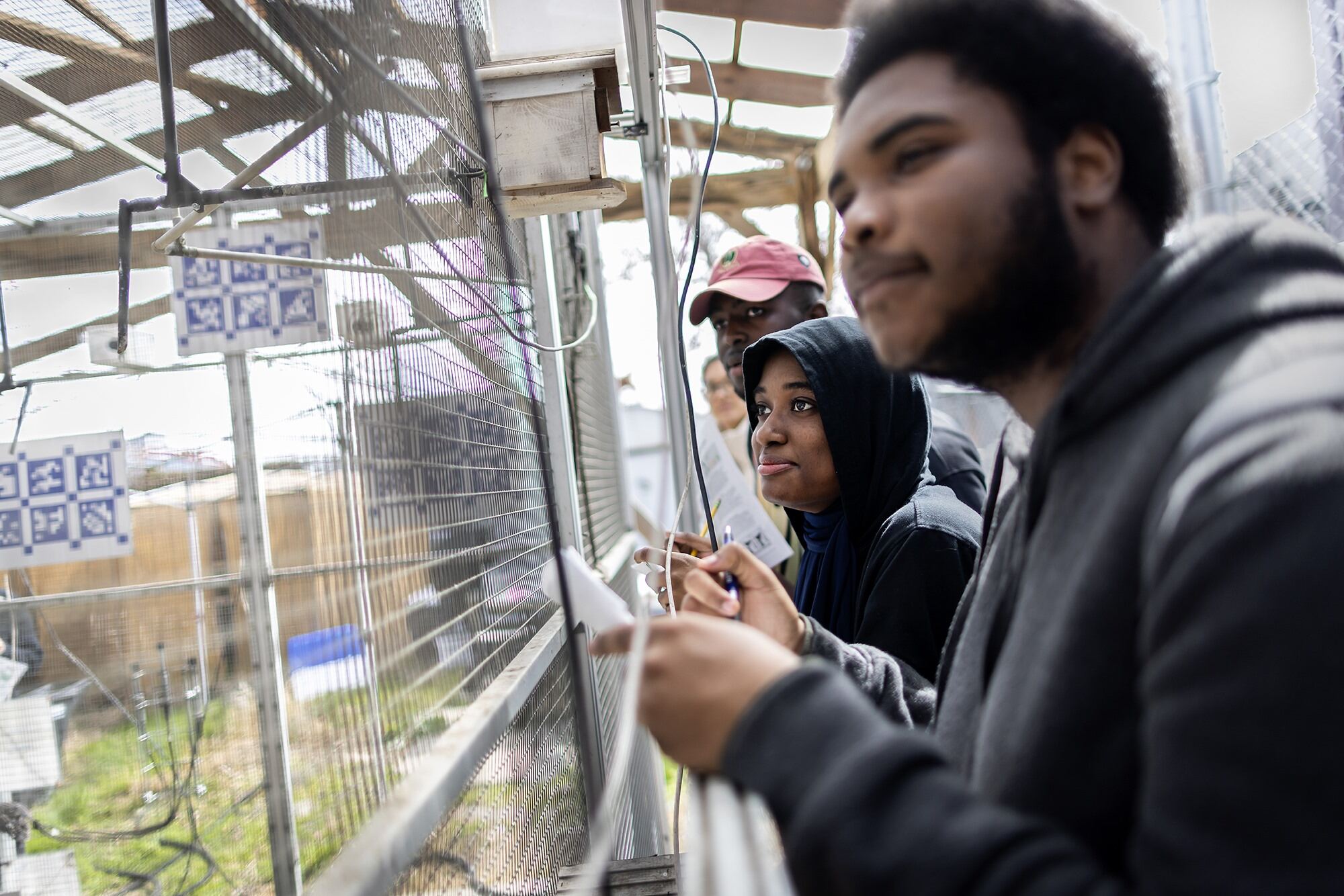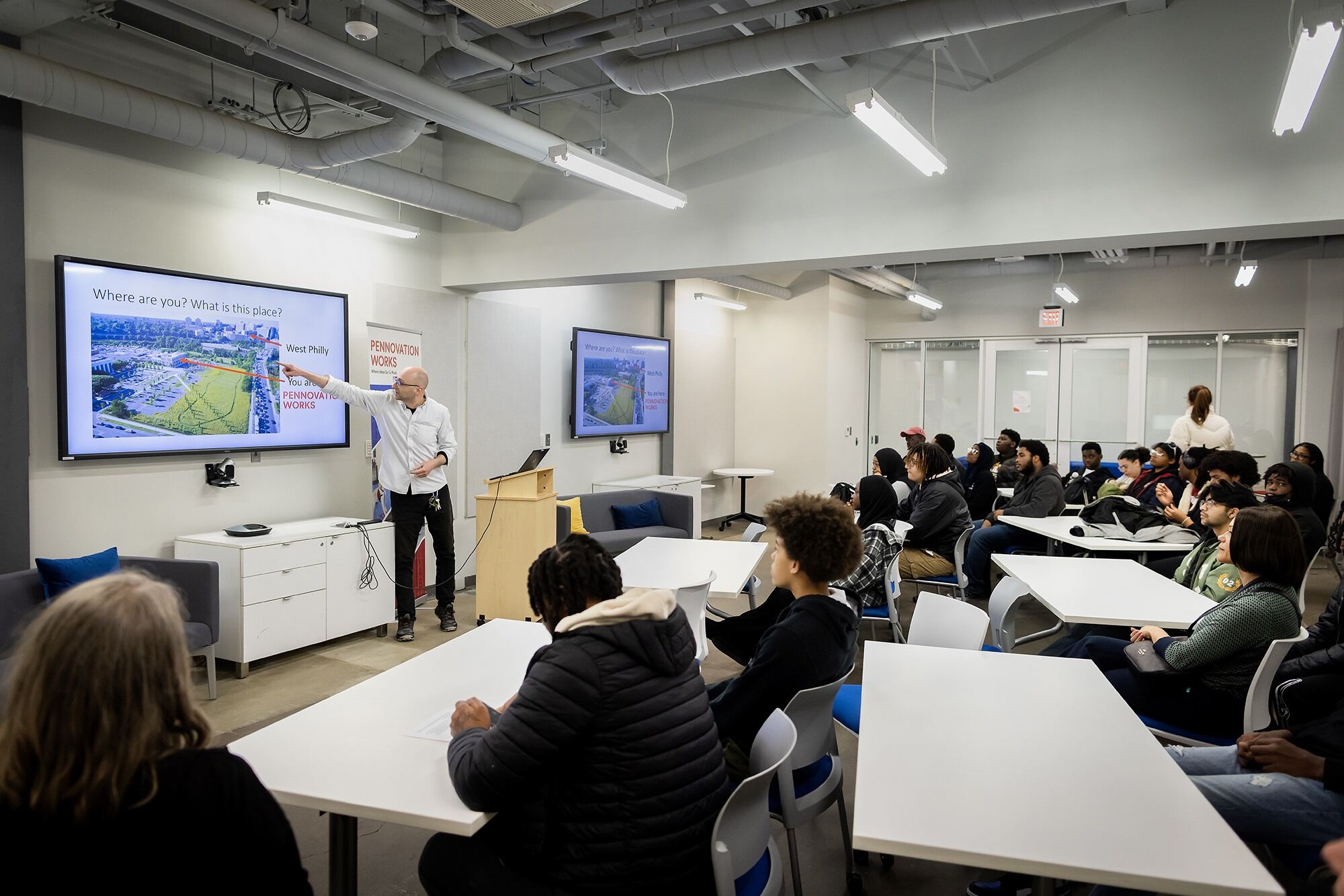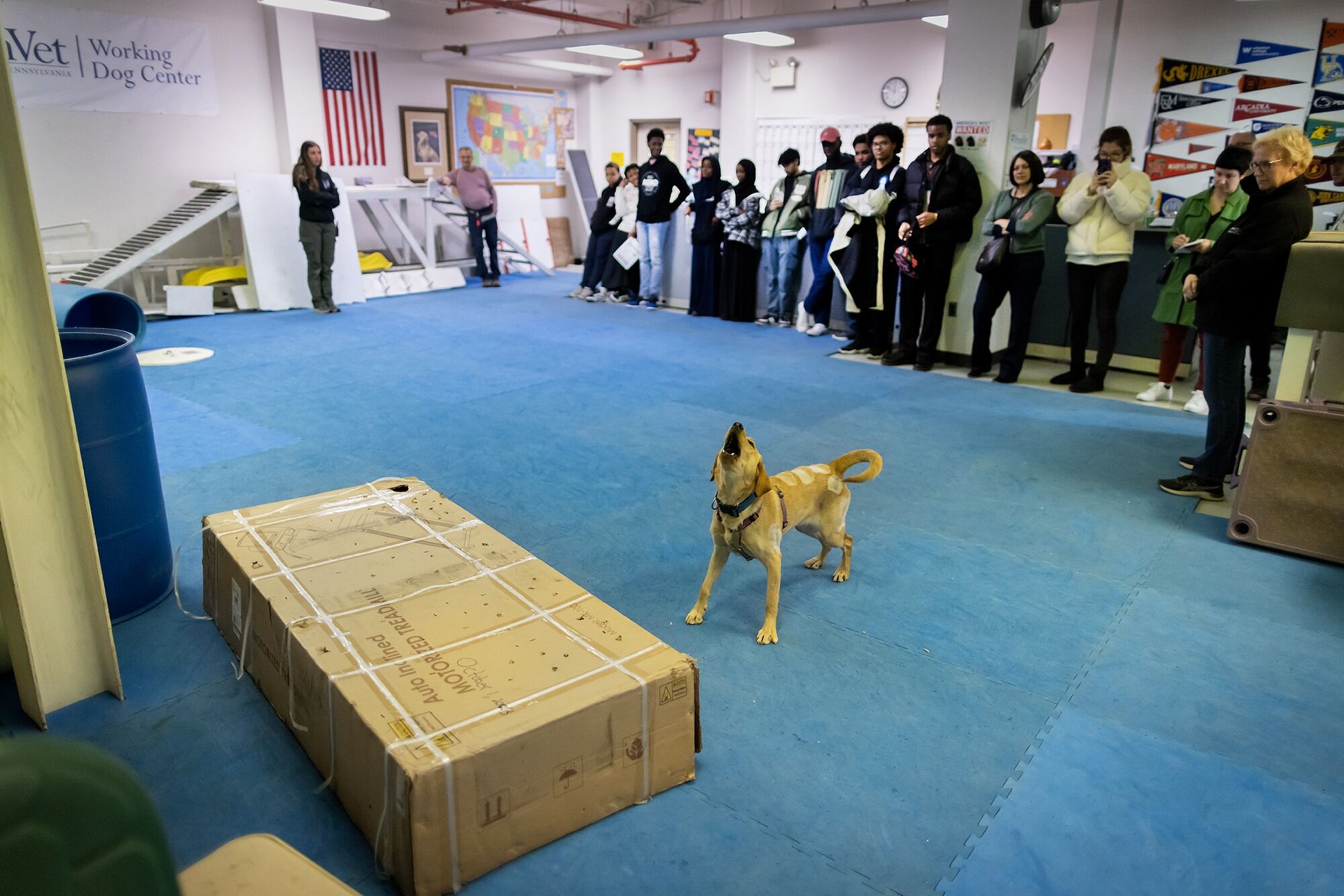
Eleven high school students stood around the 20-by-8-by-8-foot enclosure at the Penn Smart Aviary at Pennovation Works, focused on the dozen or so brown-headed cowbirds flitting from perch to perch and emitting high-pitched songs.
Biology professor Marc Schmidt and doctoral student Natalia Aponte Borges instructed the students—half of a group visiting that day from Penn Upward Bound—to tally the number of times they observed different behaviors: singing with spread wings, singing with wings down, preening, flying. The second task was to pick a single bird, identifiable by the pair of colored bands on the bird’s legs and follow the bird’s behaviors for three minutes.
“I have become really interested in understanding how the brain works in a naturalistic context,” Schmidt told the group. He is interested in learning how a male cowbird decides to be with a certain female and not another, and this spring day was just before the beginning of courtship season. Aponte Borges explained that, to understand courtship behavior across the mating season, they separate males and females before starting recordings. The students observed behaviors between males, which she said are important for establishing hierarchy in the flock.
MindCORE, Penn’s hub for the integrative study of the mind, organized a visit to Pennovation for 19 students from Upward Bound, including three from the STEM-focused Upward Bound Math and Science program, during their spring break. Students learned about cognitive science and saw research in action through talks and demonstrations at the Penn Smart Aviary, Penn Vet Working Dog Center, and GRASP Laboratory (General Robotics, Automation, Sensing & Perception).
Housed in the School of Arts & Sciences, MindCORE, which stands for the Mind Center for Outreach, Research, and Education, supports collaborative research across Penn schools and centers. MindCORE hosted Julia R. Masterman Laboratory and Demonstration School students at Pennovation a couple weeks later. Penn Upward Bound is a year-round college prep program for motivated high school students from West Philadelphia who show financial need or would be first-generation college students.
“They’re basically exactly the students we want to reach. Outreach is bringing science where it isn’t,” says Russell Richie, associate director of MindCORE and the Cognitive Science program. He said MindCORE previously had faculty speak to Upward Bound students during college prep day, and the center last summer ran a similar Pennovation tour for its summer fellows.
“Prior to this visit, students could not define cognitive science. The visit gave students the opportunity to explore diverse careers that are unfamiliar to them,” says Joann Gonzalez-Generals, director of Penn Upward Bound. “This was Upward Bound’s first visit to Pennovation Works, and it brought STEM careers to life.”
Richie began the day by explaining the meaning of cognitive science—the study of human, animal, and machine intelligence—and how it sits at the intersection of psychology, philosophy, linguistics, anthropology, neuroscience, and artificial intelligence.

He explained the benefits of cognitive science for various careers in technology, health care, and research before outlining the three tour stops and giving students some questions to mull: “How do the robots, dogs, and birds seem to perceive, think or act similarly?” “Where do the animals’ and robots’ behaviors come from?” “Why study birds or dogs?”
Samir Thomas-Cooper, a third-year student at School of the Future and an Upward Bound Math and Science student, later said he came away from the visit struck by “just how much work really goes into all this. People are really serious about gaining information on the ocean or gaining information on how birds act. Same thing with the dogs.”
Robots, birds, and puppies
The tour began in the GRASP Lab, with Ph.D. students Victoria Edwards and KongYao Chee of the School of Engineering and Applied Science talking about the lab’s work instrumenting the ocean with drifters and sensors to better understand the environment.
Edwards explained that working in robotics involves thinking about perception, intelligence, and action, referring to how robots sense the world, how they make decisions, and how they move in the environment. She talked about adaptive sampling, comparing a robot’s task of coming up with a cohesive representation of its environment to the reconnaissance that teams would undertake playing Capture the Flag. “Once you’re passionate about something, the math should not put you off,” Chee told the students.
When Edwards asked the students if they are interested in going into engineering, Nelson Okeke’s hand shot up. The Overbrook High School third-year later said he was interested learning about how robots and dogs are trained to do specific tasks and that the visit taught him to be more observant of small things.
After the GRASP Lab visit, students split into two groups and alternated going to the aviary and the Penn Vet Working Dog Center, a national research and training center that prepares dogs for work like search and rescue and law enforcement.
Ruth Desiderio, WDC volunteer and outreach coordinator, explained to the students that the Center is training dogs to be able to go into a situation—such as a building collapse in an earthquake—and use scent detection to identify whether there are survivors trapped in the rubble. Staff and volunteers demonstrated how the dogs are trained to work and perform these critical tasks with three working dogs in training: 10-week-old Skye, and 1-year-olds Whelan and Joe.
Trainer Kathryn Eland inched into a barrel on her stomach and pulled a round cover in front of the opening, ready for Skye to come find her. “This puppy is at the stage where she is just having fun, seeing the person in the barrel, and barking” to alert others to Eland’s presence, trainer Alena Heyer said as Skye entered the facility.
After Skye barked several times at the barrel, as she has been trained to do, Eland provided some positive reinforcement by offering Skye’s favorite toy from behind the cover. It was now playtime. “What a good pupper! Good girl!” Eland said in an excited voice and tone that Desiderio said dogs love.
At the end of the visit to Pennovation, Roman Catholic High School third-year student Nigel Stewart reflected on how intelligence manifests differently, noting that the dogs had a goal, the birds exhibited different behaviors, and the robots performed certain tasks.
Stewart said the visit showed him that cognitive science can merge psychology and artificial intelligence or linguistics and philosophy and that the field is very broad: “Your options are open.”

